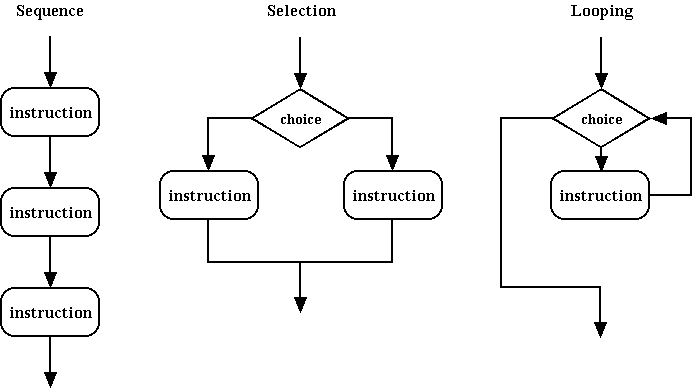Write the word 'sum' on the board and put a 0 underneath it. Add 5 to the number written under 'sum' and put the result under 'sum'. Add 10 to the number written under 'sum' and put the result under 'sum'. Add 13 to the number written under 'sum' and put the result under 'sum'. The number written under 'sum' is the sum of 5, 10, and 13.
In this example, the word 'sum' is like a variable. If we were writing this algorithm for App Inventor it might look like this, where Sum is a global variable.
Set Sum to 0. Set Sum to Sum + 5 Set Sum to Sum + 10 Set Sum to Sum + 15
Here's an App Inventor Procedure that implements this algorithm:

Of course this algorithm is somewhat artificial. It doesn't really
need 4 steps because it can be expressed more simply as:

Questions:
- Is there any reason to prefer one algorithm over the other?
- Are both algorithms correct?
- Is one more efficient than the other?
- Is one more more clearly expressed than the other?
- Is one easier to generalize than the other?
Adding Three Numbers in a List
Suppose we represent a list of numbers by using parentheses: (5 10 13). Here's an algorithm for calculating the sum of this list of 3 numbers.
Set Sum to 0. Set Sum to Sum + the first number in the list. Set Sum to Sum + the second number in the list. Set Sum to Sum + the third number in the list.
When we say the first number of the list we are indexing the list. This is a common step in computer algorithms.
Here's an App Inventor Procedure that implements this algorithm. Note that the
select list item block takes an argument for the list's index:

Abstraction: Note how the argument slots in the select list item block generalize the operation of selecting an item from a list.
Adding Just the Two-Digit Numbers in the List
Suppose we wanted to add just the two-digit numbers in our list of three numbers. We could use this algorithm:
Set Sum to 0. If the first number in the list >= 10 Set Sum to Sum + the first number in the list. If the second number in the list >= 10 Set Sum to Sum + the second number in the list. If the third number in the list >= 10 Set Sum to Sum + the third number in the list.Or we could use this algorithm that uses a second global variable, called NumberSet Sum to 0. Set Number to the first number in the list. If Number >= 10 Set Sum to Sum + Number. Set Number to the second number in the list. If Number >= 10 Set Sum to Sum + Number. Set Number to the third number in the list. If Number >= 10 Set Sum to Sum + Number.
Here's two App Inventor way to express these two algorithms:
 |
 |
Questions:
- Is there any reason to prefer one algorithm over the other?
- Are both algorithms correct?
- Is one more efficient than the other?
- Is one more more clearly expressed than the other?
- Is one easier to generalize than the other?
Adding N Numbers in a List
Suppose your list could have a variable number of numbers in it. Here's an algorithm for that.
Here's how we would do this in App InventorSet Sum to 0. Set Index to 1. While Index <= the length of the list Set Sum to Sum + the list item at Index Set Index to Index + 1

Summary Observations
- The basic unit of an algorithm is a statement.
Statement Type Example Assignment: Set Sum to 0 Assignment: Set Sum to Sum + 10 If/Then: If Number > 10 then-do Set Sum to Sum + 10 Loop: While Index <= Length of List do: Set Index to Index + 1 Procedure call: Call SomeProcedure - Algorithms can be composed out of combinations of
three basic control structures: sequence, selection (if/then), repetition or looping (while):
Sequence Selection Repetition Set Sum to 0. Set Sum to Sum + 5 Set Sum to Sum + 10 Set Sum to Sum + 15
Set Sum to 0. If the first number in the list >= 10 Set Sum to Sum + the first number in the list. If the second number in the list >= 10 Set Sum to Sum + the second number in the list. If the third number in the list >= 10 Set Sum to Sum + the third number in the list.
Set Sum to 0. Set Index to 1. While Index <= the length of the list Set Sum to Sum + the list item at Index Set Index to Index + 1
- Algorithms can be expressed in different languages
In-class Exercises
- Write a Pseudocode algorithm to sum all the single digit numbers in MyList storing the result in Sum.
- Test your algorithm by tracing it step-by-step on the list (14 5 3 21)
- Write an App Inventor version of this algorithm.
- Test your App Inventor algorithm by right clicking on blocks and using Watch and Do it.
Homework Exercises (Due Friday)
- Write a Pseudocode algorithm to compute whether or not a number is odd, storing the result, true or false, in a global variable.
- Using your isOdd algorithm as a part, write a Pseudocode algorithm to sum all the odd numbers in MyList storing the result in Sum.
- Test your algorithm by tracing it step-by-step on the list (14 5 3 21 5 6)
- Write an App Inventor version of this algorithm.
- Test your App Inventor algorithm by right clicking on blocks and using Watch and Do it.

